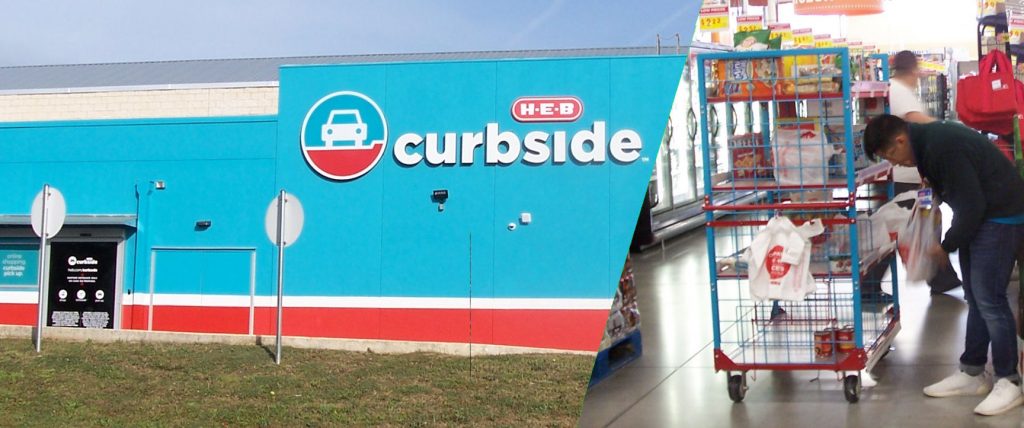
If you would like to watch displacement by a new technology coming into your life, just watch at your local supermarket.
James Lyman BSAE, BSEE, MSSM
I do our weekly grocery shopping, each Wednesday morning like clockwork, and in the last year or so I’ve seen these multi-shelf wire carts being pulled through the store by young kids, seemingly absorbed by the screens of their smart phones, appearing to be oblivious to all about them. Up and down the aisles they go, stopping occasionally to pick an item or two off the shelves to fill plastic grocery bags which rest on these wire shelves. In actuality, they are doing the physical shopping for HEB customers. The customer uses an app on their smart phones to compile their shopping list, which then goes to one of the young shopper’s smart phone to be gathered up. At a later time, the customer pulls up to a delivery door on the side of the store, gathers up the order and is off for home in just minutes.
This is the newest innovation in retailing, both dry goods and foodstuff. Attempts are being made by a number of different retailers to further automate their store operations, thereby remaining competitive and not becoming another Sears and Roebuck chain. Trouble is, it’s too labor intensive! Automation means doing more with fewer people, so how can this be an example of new unfolding automation technology? Quite simply this is the start, not the end of development, and right now, HEB and other retailers are feeling out the market, researching just how best to develop it for their future.
To reduce their labor cost, companies like HEB need to go to a central location for filling orders, where warehouse automation systems can be used to fill those orders. This is an area of technology which is highly advanced and proven. Modern warehouses require far fewer material handling people to operate than just a decade or two ago. Since the customer orders are electronic, they would automatically go to the central warehouse to be filled. I envision using plastic impregnated corrugated tote boxes like the Post Office uses, which are cheap yet durable. Each tote box has a unique bar code, so once scanned with a hand held bar code reader, the tracking software knows which order that a tote box is associated with. These tote boxes could be color coded, blue for cold stuff, white for general dry foods, pink for cleaning chemicals, green for produce and so on.
A person would go down an aisles making stock pulls for a tote box, then at the end place the box on a powered conveyer. Having bar codes, the tote boxes can be automatically sorted to which truck (store) that tote goes to. The totes may be set on a multi level rack with wheels, so a truck is loaded merely by pushing these rack carriers into the truck, then closing the trailer doors. Each of the carrier racks also have unique bar codes and so the computer network knows which tote box is on which rack. Cold and frozen food stuff goes by separate trucks. The truck then delivers to the designated store to be later picked up.
Once at the store, the racks are rolled out of the truck, sorted and checked to ensure all the totes for an order are present, then when the customer arrives, the clerk only has to push the cart of totes out to the waiting car. The previously used totes are scanned and a deposit charge for each tote (2 to 3 dollars) is deducted from the customer’s account. Then the new totes are loaded into the car, each scanned a second time to ensure completeness of order, while the deposit charge for each tote is added to the customer’s account. So in just a minute or so, the customer is off to continue driving home, the grocery shopping chore now done.
So just how does such a system reduce labor cost? Well, to start with, the central warehouse works directly off pallets and such, so there’s no labor involved in stocking shelves as with conventional stores. With a well designed automated warehouse, the stock pullers fill more orders per day than presently done by in-store pullers walking around the store with their carts, while also getting in the way of customers. Now if 30 to 40% of the shoppers are using the automated shopping service, then there’s a reduction of the number of shoppers the store has to process, which in turn means a reduction in the number of cashiers, the number of people sacking the groceries, the number of support people and fewer man-hours spent stocking the shelves. Suddenly, there’s a very significant savings in labor which translates directly into monetary savings and therefore increased profits.
In practice, the customer would use the smart phone app to note items are needed as they are found, much like writing a conventional shopping list. Say you’re running low on plastic trash bags, then just whip out the phone and check it off. Then just as with a written shopping list, the evening before going shopping, the customer sits down and checks off what food items are wanted for the next several days or week. Once done, the order is placed, as well as the time for pickup, then next day after work, the customer swings into HEB’s pickup station on the way home (or uses one of the emerging delivery services) and presses a button on the app to signal he has arrived. A unique bar code appears on his smart phone, which the clerk scans to make sure it’s the right customer, then in less than a minute has the order loaded into the car. Payment is electronic and has already been made and approved.
And now that you know what to watch for, you can observe the process of a new technology moving into your life and the displacement that follows. This is a very serious business that spells the difference of life and death for a retailer, whether there is going be an HEB or another Sears and Roebuck. Years ago, when WalMart brought their super stores to San Antonio, someone made the snide remark to the newspaper that HEB should just fold it up and let WalMart take over, just like so many competitors had done in the past! They didn’t realize that WalMart’s advantage has always been they were so highly automated . . . and that HEB was just as automated as WalMart. For once, WalMart was taking on an equal, and this time there wasn’t the easy pushover they were expecting.
I just read an article that WalMart has acquired Jetblack, a personal-shopping company which WalMart intends to use as a teaching device for their new AI system they expect to have operating in the next 5 to 7 years. To WalMart, Jetblack is a research tool instead of a business enterprise, this is how serious technology development is for ALL retailers. For them, it’s a matter of life and death! HEB and other retailers have no real choice whether to automate or not, because their only alternative is the decline and then demise of their company.
That’s the primary driving force of automation for any business.
As millennials and generation-Z face increasing challenges of new technologies and displacement, they need to realize there’s no stopping or controlling those technologies. Even if a nation’s government was to restrict the growth of technology to preserve jobs, the baton of advance technology would just pass to another country leaving the ‘restricting nation’ to wilt on the vine. So the millennials and generation-Z have no alternative but to also advance technologically.
